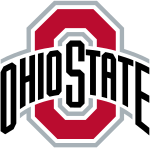| Ohio State Buckeyes men's lacrosse | |
|---|---|
 | |
| Founded | 1953 |
| University | Ohio State University |
| Head coach | Nick Myers (since 2009 season) |
| Stadium | OSU Lacrosse Stadium (capacity: 1,800) |
| Location | Columbus, Ohio |
| Conference | Big Ten Conference |
| Nickname | Buckeyes |
| Colors | Scarlet and gray [1] |
| NCAA Tournament Runner-Up | |
| 2017 | |
| NCAA Tournament Final Fours | |
| 2017 | |
| NCAA Tournament Quarterfinals | |
| 2008, 2013, 2015, 2017 | |
| NCAA Tournament appearances | |
| 2003, 2004, 2008, 2013, 2015, 2017, 2022 | |
| Conference Tournament championships | |
| 2013 | |
| Conference regular season championships | |
| 1965, 1966, 1978, 1986, 1988, 1992*, 1999, 2003, 2004, 2008, 2014, 2025 *Vacated | |
The Ohio State Buckeyes men's lacrosse team represents Ohio State University in National Collegiate Athletic Association (NCAA) Division I college lacrosse. The program was created in 1953. Ohio State plays its home games at the OSU Lacrosse Stadium, which has a capacity of 2,200. The Buckeyes have competed in the Big Ten men's lacrosse conference since 2015.
Contents
Through 2024, the team has an all–time record of 523-457-5. [2] In 2008, Ohio State won its first NCAA men's lacrosse tournament game, defeating Cornell, 15–7, before falling to Duke, 21–10, in the quarterfinals. In 2013, they recorded their second tournament win, defeating Towson, 16–6. [3] In 2017, they made their first Final Four appearance in school history. They beat Towson in the semifinals, but lost in the championship to Maryland, 9-6.
